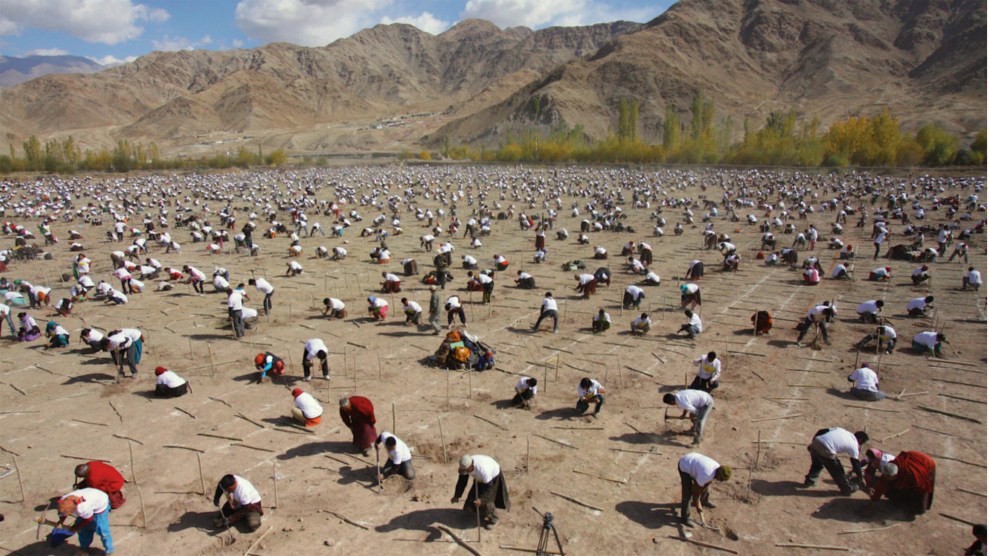
The Ottauquechee River in Woodstock, Vermont.Ralph Lauer/Zuma
This story was originally published by the Guardian and is reproduced here as part of the Climate Desk collaboration.
Trees provide innumerable benefits to the world, from food to shelter to oxygen, but researchers have now found their dramatic rebound in the eastern US has delivered a further, stunning feat—the curtailing of the soaring temperatures caused by the climate crisis.
While the US, like the rest of the world, has heated up since industrial times due to the burning of fossil fuels, scientists have long been puzzled by a so-called “warming hole” over parts of the US south-east where temperatures have flatlined, or even cooled, despite the unmistakable broader warming trend.
A major reason for this anomaly, the new study finds, is the vast reforestation of much of the eastern US following the initial loss of large numbers of trees in the wake of European settlement in America. Such large expanses have been reforested in the past century—with enough trees sprouting back to cover an area larger than England—that it has helped stall the affect of global heating.
“The reforestation has been remarkable and we have shown this has translated into the surrounding air temperature,” said Mallory Barnes, an environmental scientist at Indiana University who led the research. “The ‘warming hole’ has been a real mystery and while this doesn’t explain all of it, this research shows there is a really important link to the trees coming back.”
There was a surge in deforestation from the start of the US’s early colonial history, as woodland was razed for agriculture and housing, but this began to reverse from around the 1920s as more people began to move into cities, leaving marginal land to become populated again with trees. The US government, meanwhile, embarked upon an aggressive tree-planting program, with these factors leading to about 17 million acres of reforested area in the past century in the eastern US.
The recovery of the US’s eastern forests has blunted global heating mainly through the trees’ transpiration, in which water is drawn up through the roots to the leaves and then released into the air as vapor, slightly cooling the surrounding area.
By poring over data from satellites and weather stations located across the eastern US from 1900 to 2000, Barnes and her colleagues found reforested areas have provided this cooling impact on a grand scale, with most of this effect occurring within 400 meters of the trees.
In all, the replenished forests today cool the eastern US by 1C to 2C (1.8F to 3.6F) each year. The cooling effect is strongest on the hottest days in summer, when trees lower temperatures by 2C to 5C (3.6F to 9F), the researchers found.
The researchers cautioned that bringing back trees hasn’t been the sole cause of the stalled warming, with factors such as airborne pollutants, which block incoming sunlight, and agricultural irrigation also potential causes. But Barnes said that the findings should further bolster efforts to provide thoughtful reforestation, particularly near urban communities that suffer particularly scorching temperatures due to a lack of shady trees.
“Trees have a really beneficial impact upon surface temperatures through transpiration, which is similar to human sweating, and they have really cooled things off a lot,” said Barnes. “Moving forward, we need to think about tree planting not just as a way to absorb carbon dioxide but also the cooling effects in adapting for climate change, to help cities be resilient against these very hot temperatures.”
Patrick Gonzalez, a University of California, Berkeley, climate change scientist and forest ecologist who wasn’t involved in the new study, said the work provides “strong support” to the theory of cooling trees.
“Cutting carbon pollution from cars, power plants and other human sources that burn coal, oil and methane remains the essential solution to halt climate change,” he said. “Natural regeneration of trees and reforestation, where ecologically appropriate, can contribute substantially.”
Barnes, too, stressed that reforestation was no substitute for the need to drastically cut planet-heating emissions, which hit a new global high last year.
“Nature-based climate solutions like tree planting won’t get us out of this climate change problem,” she said. “If anyone thinks we can just plant a few trees and be OK, they are wrong—we need a massive reduction in fossil fuel emissions to hit our targets. Reforestation is something that needs to happen in addition to, not instead of, cutting emissions.”















